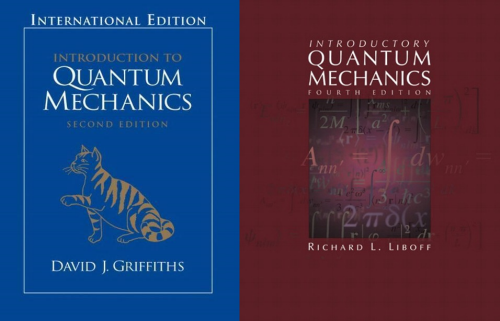[Appendix] Quantum Mechanics for General Knowledge (1)

Quantum Mechanics for General Knowledge
As I wrote "Quantum mechanics, Economics, and Theory of Evolution" earlier, I explained quantum mechanics in a difficult way for the purpose of writing. So I want to set up a separate page to introduce quantum mechanics at the level of general knowledge.
The blue book and the red book shown above are the books that I first saw when I learned quantum mechanics. Isn't it a cool cover? When I put them side by side, it looks like a yin-yang symbol.
Is not it? Then let's see
Ta-da!

Now, It become a real yin-yang symbol.
In an old Asia philosophy, yin and yang are the fundamental elements that make up everything in the universe. And in modern physics, quantum mechanics is the study of the fundamental elements of the universe. Interestingly enough, in Korean words, protons are said to have "yang" charges and electrons are said to have "yin" charges (maybe most Asian country call them in similar way). It's as if the two books were saying, " We are the yin and yang of quantum mechanics! You have to go through us to learn quantum mechanics!"
However, unfortunately these two books can not be introduced for you. These books are full of formulas, and formulas appear even before even the table of contents. Perhaps you will close the cover as soon as you open it.
So what I'd like to recommend to you is documentaries. Among several documentaries, I recommend Brian Greene's " The Fabric of The Cosmos", produced by NOVA in 2011, which offers easy-to-understand descriptions and visuals to the public. The documentary is a total of tetralogy as follows and each is about 50 minutes long.
 |  |
|---|---|
 |  |
I'll review all four someday, but now I want to summarize and explain to you the third part which explains quantum mechanics. If you have time, I suggest you watch the video yourself. And if you don't have 50 minutes to spare, I think you should just watch it. I will mark the part that I add my own explanation with *
The Fabric of The Cosmos : Quantum Leap
It begins with Greene visiting a club governed by the laws of quantum mechanics.
![NOVA The Fabric of The Cosmos 3 - Quantum Leap[(009663)2018-02-17-00-19-17].png](https://steemitimages.com/640x0/https://steemitimages.com/DQmUvTYA591KqaUQ3L4keFBXKBUmw1hNdpes9uzu975Ymvk/NOVA%20The%20Fabric%20of%20The%20Cosmos%203%20-%20Quantum%20Leap%5B(009663)2018-02-17-00-19-17%5D.png)
The club is a lot strange.
![NOVA The Fabric of The Cosmos 3 - Quantum Leap[(011377)2018-02-17-00-20-28].png](https://steemitimages.com/DQmdDbPpm8c4ysrfARkiyQ3mx4onnhrkcdfz7gYhN5DUeQL/NOVA%20The%20Fabric%20of%20The%20Cosmos%203%20-%20Quantum%20Leap%5B(011377)2018-02-17-00-20-28%5D.png)
- The same person is coming from all over the place at a time.
- The same ball moves in several paths simultaneously.
- Greene hits the ball on one side of the pool table, then immediately the balls of the next pool table moved.
- Greene doesn't know exactly where people are, but they can be almost anywhere until you look for them.
It's a strange law, but even with experiments and experiments, the quantum law have always been right.
![NOVA The Fabric of The Cosmos 3 - Quantum Leap[(014798)2018-02-17-00-45-23].png](https://steemitimages.com/640x0/https://steemitimages.com/DQmNjHVPMPLLb5oZF6mDP5Meie8cXvnwMmHVky4dV4djQEr/NOVA%20The%20Fabric%20of%20The%20Cosmos%203%20-%20Quantum%20Leap%5B(014798)2018-02-17-00-45-23%5D.png)
Not long ago, we thought we had it pretty much figured out the laws of physics like how the planet is moving around the sun, how the ball arcs though the sky, and how the ripples move across the surface of pond. (*This refers to classical mechanics represented by Newton. Classical mechanics predicted the results from a series of equations. And this led to a determinism, in which you know all the contributing variables and you know the consequences.)
![NOVA The Fabric of The Cosmos 3 - Quantum Leap[(016857)2018-02-17-01-19-15].png](https://steemitimages.com/DQmea7QvqqyVeLdDzAFNKPzK4A8TnkgjDuJic8MNcFwE9U5/NOVA%20The%20Fabric%20of%20The%20Cosmos%203%20-%20Quantum%20Leap%5B(016857)2018-02-17-01-19-15%5D.png)
However, while scientists were experimenting on the nature of light, they observed one unusual phenomenon. When the kind of light from the heated gases in a glass tube passes through a prism, the light split exactly in a several colors as in the picture above. It was supposed to be in a continuous color, like a rainbow.
![NOVA The Fabric of The Cosmos 3 - Quantum Leap[(019072)2018-02-17-01-22-22].png](https://steemitimages.com/640x0/https://steemitimages.com/DQmTrvPisDqYhwEWE1kvBmxqjCgk67oyhZihEo7TNas6MW9/NOVA%20The%20Fabric%20of%20The%20Cosmos%203%20-%20Quantum%20Leap%5B(019072)2018-02-17-01-22-22%5D.png)
Niels Bohr sets the following hypothesis to solve this problem.
- The electrons, like the solar system, orbit around nucleus.
- But the electrons can not move in just any orbit, instead only in certain orbits allowed.
- The electrons leap from one fixed orbit to another, not going through the middle area.
- The energy in the form of light is emitted when electrons move from a large orbit to a small one.
* The emission of light when leaping from orbit high to orbit low can be understood by comparison with balls falling from high place. while A ball falling from a high place increases its speed and generates kinetic energy, an electron generates light energy by falling into a low orbit. However, although the ball continuously passes through space and the kinetic energy continuously increases, the electrons jump out of space and emit only a fixed amount of light energy. This explains how the gases emit only a consistent light, as shown in the picture.
Afterwards, the experiments supporting Bohr's hypothesis were shown one by one, which triggered studies of quantum mechanics. As quantum mechanics developed, it got out of the logic of classical mechanics. Double slit experiment shows these sorts of characteristics of quantum mechanics.
![NOVA The Fabric of The Cosmos 3 - Quantum Leap[(027669)2018-02-17-02-35-33]-horz.jpg](https://steemitimages.com/DQmPn5q1apQ84c7tcp3SWasraKcSyMECSnbfW4cwuujKZzA/NOVA%20The%20Fabric%20of%20The%20Cosmos%203%20-%20Quantum%20Leap%5B(027669)2018-02-17-02-35-33%5D-horz.jpg)
Greene starts with an experiment in the world of classical mechanics. He rolls the bowling ball to the screen behind the barrier with two gaps. The bowling ball enters the left gap or the right gap. A ball that hits the middle between the gaps will bounce off. The result is, as expected, every ball that enters the left gap reaches the left side of the screen, and every ball that enters the right gap reaches the right.
![NOVA The Fabric of The Cosmos 3 - Quantum Leap[(029002)2018-02-17-02-40-40]-horz.jpg](https://steemitimages.com/640x0/https://steemitimages.com/DQmU59zYcb4if9Q2td71ghDWg3Q7w7M9L3R4Hdzi5GJfzSQ/NOVA%20The%20Fabric%20of%20The%20Cosmos%203%20-%20Quantum%20Leap%5B(029002)2018-02-17-02-40-40%5D-horz.jpg)
But in the world of quantum mechanics, the result is different. The electrons reach even the middle part of screen blocked by the double slit. What this mean is clear. It is a 'wave'. But physicists could not interpret this results at that time. they did not know what this wave meant.
![NOVA The Fabric of The Cosmos 3 - Quantum Leap[(030625)2018-02-17-02-41-28].png](https://steemitimages.com/DQmbMUoMuNQEusez4uxoFsB39NG4EaNKxij5bpfTH3etzfL/NOVA%20The%20Fabric%20of%20The%20Cosmos%203%20-%20Quantum%20Leap%5B(030625)2018-02-17-02-41-28%5D.png)
Schrödinger, who created the Schrödinger equation, thought this wave was a description of an extended electron that somehow an electron got smeared out, and it was no longer a point but was like a mush. but his thought was not accepted among the scientists. The argument between physicists about exactly what this represented continued, until Max Born came up with the concept of a "probability wave". Probability wave means the probability of the electron being located. In other words, the size of the wave indicates the likelihood of the electron being found there, and the larger the size of the wave, the higher the probability of the electron being found.
In the concept of the probability wave, it is not allowed to question where the electron is located. The right question is what the probability is that an electron will be found there.
And that probability can be calculated by solving the Schrödinger equation.(* The Schrödinger equation seems complicated, but ultimately the left hand side represents the sum of the energies, and the right hand side represents kinetic energy + potential energy)
The fact that electrons can not be known where they exist exactly, but only probabilities, makes quantum mechanics look useless. But really it is not true. Because when the number of electrons is large, in accordance with the law of large numbers, the behavior of them can be accurately predicted. For example, when you roll a dice, you have absolutely no idea what number will come out, but if you throw it about 600,000 times, you can predict that each number will come out about 100,000 times evenly. Similarly, when there is only one electron, it can not be predicted at all, but when the number is large, it becomes predictable.
![NOVA The Fabric of The Cosmos 3 - Quantum Leap[(042504)2018-02-17-02-51-13].png](https://steemitimages.com/DQmXiNGS8aP8DRV9Xm7QxLzUYDwURNXn5jF9ERPE7ctG4Cd/NOVA%20The%20Fabric%20of%20The%20Cosmos%203%20-%20Quantum%20Leap%5B(042504)2018-02-17-02-51-13%5D.png)
Th fact that at base the nature was described by an inherently probabilistic theory, which was highly counterintuitive made many people have a difficulty accepting it. But a lot of physicists accepted quantum mechanics soon. Because the equation of quantum mechanics gave them the power to predict the behavior of groups of atoms and tiny particles with astounding precision. Before long, that power would lead to some very big inventions. Lasers, transistors, the integrated circuit, and the entire field of electronics were those.